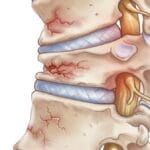Introduction
Erb’s Palsy, also known as Brachial Plexus Birth Palsy, is a condition that results from injury to the brachial plexus nerves during childbirth. This network of nerves controls muscles in the shoulder, arm, and hand, and when damaged, can lead to weakness or paralysis of the affected arm. The condition typically affects the upper nerves (C5 and C6), although it can also involve other nerves.
Causes of Erb’s Palsy
Erb’s Palsy commonly occurs due to complications during childbirth, including:
- Shoulder Dystocia: This occurs when a baby’s shoulder becomes lodged behind the mother’s pubic bone, causing excessive pulling on the neck and resulting in nerve damage.
- Breech Birth: Deliveries in which the baby is positioned feet-first increase the risk of brachial plexus injury.
- Use of Delivery Tools: The use of forceps or vacuum extraction can cause undue stress on the baby’s brachial plexus nerves.
- Prolonged Labor: Extended labor can increase the likelihood of nerve damage.
- Excessive Pulling: Excessive pulling or lateral traction on the baby’s head during delivery can result in nerve damage.
Symptoms of Erb’s Palsy
Symptoms of Erb’s Palsy vary in severity depending on the extent of the nerve injury and may include:
- Weakness in the affected arm
- Partial or complete paralysis of the shoulder, arm, or hand
- Loss of sensation in the arm
- Pain or discomfort
- The characteristic “waiter’s tip” position, where the arm hangs by the side and is rotated inward with the hand turned backward
Types of Nerve Injuries
The severity of nerve injury in Erb’s Palsy can be classified into several types:
- Neurapraxia: This is the mildest form of nerve injury, where the nerve is stretched but not torn. Recovery is usually complete.
- Neuroma: This occurs when scar tissue forms around the injured nerve, potentially pressing on healthy nerve fibers and inhibiting recovery.
- Rupture: This involves a torn nerve that requires surgical intervention to reconnect.
- Avulsion: This is the most severe form, where the nerve is torn from the spinal cord, often necessitating complex surgical repair and resulting in varying degrees of recovery.
Diagnosis
Diagnosis of Erb’s Palsy typically involves:
- Physical Examination: Assessing the range of motion and strength in the baby’s arms.
- Imaging Tests: X-rays, MRI, or CT scans can help evaluate the extent of nerve damage and rule out other conditions.
- Electromyography (EMG): This test measures the electrical activity of muscles and can help determine the severity of nerve damage.
Treatment
Treatment for Erb’s Palsy depends on the severity of the injury and may include:
Non-Surgical Treatments:
- Physical Therapy: Early intervention with physical therapy is crucial to maintain joint flexibility and muscle strength. Exercises focus on improving range of motion and preventing stiffness.
- Occupational Therapy: Helps improve fine motor skills and the ability to perform daily activities.
Surgical Treatments:
- Nerve Grafting: Transplanting healthy nerves from another part of the body to repair damaged nerves.
- Nerve Transfer: Redirecting a functioning nerve to take over the function of a damaged nerve.
- Tendon Transfers: Transferring tendons from one muscle to another to improve movement and function.
- Muscle Transfers: Transplanting muscles from one part of the body to restore function to the affected arm.
Rehabilitation
Rehabilitation is a critical component of recovery from Erb’s Palsy. It often involves:
- Physical Therapy: To improve strength, flexibility, and function of the affected arm.
- Occupational Therapy: To enhance the ability to perform daily tasks and improve fine motor skills.
- Regular Monitoring: Ensuring progress and adjusting treatment plans as necessary.
Prognosis
The prognosis for Erb’s Palsy varies depending on the severity of the injury. Many infants with mild cases recover fully with early intervention and therapy. Severe cases may require surgical intervention and have a more guarded prognosis. Early and appropriate treatment significantly improves outcomes.
Prevention
While not all cases of Erb’s Palsy can be prevented, certain measures can reduce the risk:
- Proper Management of Labor and Delivery: Careful monitoring and timely intervention during labor can help prevent complications.
- Awareness of Risk Factors: Recognizing risk factors such as large infant size, prolonged labor, and abnormal fetal positions can help healthcare providers take preventive measures.
- Elective Cesarean Section: In cases with known risk factors, a C-section may be recommended to avoid complications during vaginal delivery.
Conclusion
Erb’s Palsy is a significant condition that requires timely and appropriate treatment for optimal recovery. Understanding the causes, symptoms, and treatment options is crucial for effective management. Consulting with healthcare professionals specializing in brachial plexus injuries can provide the best outcomes for affected individuals.





